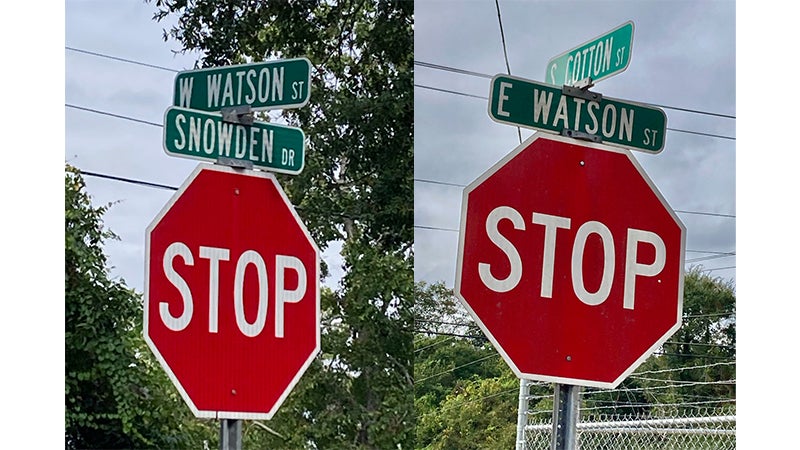Remember When: History of the public square
Published 2:00 pm Friday, September 29, 2023

- W. Watson and E. Watson streets could be named after John Alvin Watson II. (PHOTOS PROVIDED)
|
Getting your Trinity Audio player ready...
|
A framed map, a drawing of downtown Andalusia dated 1896, hangs in my office. It is identified as a “Copy of original plat of Andalusia, Alabama” made by Ezekial Watson. This leads us to believe that before the village of Montezuma moved up the hill to higher ground, the “new site” was planned and drawn off on paper. Its caption reads “…made after courthouse burned in 1875 and again in 1895.”
Some streets labeled on the map that we recognize today as official city streets include Cotton Street, Coffee Street, Troy Street, Pear Street, and Yellow River Street. Street names in and around the Public Square that probably never were opened or names later changed include Water Street, Saw Mill Street (Church Street), Greenland Street (East Three Notch Street), Conecuh Street (South Three Notch Street), Alley Street, James Street, Pigeon Creek Street, Stanley Street, and King Street.
That is much like modern day subdivisions that are often drawn off on paper with streets that were originally planned but never opened or made accessible – very similar to the Meadowbrook Subdivision.
In researching information recently in the old newspapers, I ran across this obituary of John Alvin Watson II, retired owner and operator of the Andalusia Iron Works who passed away in 1957 at the age of 68 years.
The Andalusia Star News reported, “A native of Andalusia, Mr. Watson was the grandson of the late Ezekial Watson who received a government grant of land to establish Andalusia’s first post office at the location where Wallace’s Store is now located. (That is the location of the present day Ward and Company on the Court Square.)”
“The Watson family was preceded in Andalusia only by the Prestwood family. Ezekial Watson donated the land for the City Square, the Court House, the Baptist Church and Cemetery, and a school site on the Brewton Highway.”
“As a youth, John A. Watson was reared on the Watson farm near Watson’s Ferry Crossing. He at one time operated for many years a blacksmith shop adjoining J. W. Shreve and Sons (on North Cotton Street).”
“Subsequently, Watson moved with his family to Evergreen for a time where he operated the Evergreen Bus Works before returning to Andalusia to operate the Andalusia Iron Works (around 1950). He sold that business several months ago to M. L. Moore when his failing health required his retirement.”
An editorial about that time states and I quote, “The death of Mr. J. A. Watson, one of Andalusia’s beloved citizens, brings up some old history. Mr. Watson’s father, the original J. A. Watson, formerly operated a ferry at the Conecuh River crossing between Andalusia and Brooklyn. A bridge stands at the site today, but old timers still refer to the location as Watson’s Ferry Landing.”
Are there any old timers today who remember that ferry?
Burial for Mr. J. A. Watson was in the Andalusia Memorial Park Cemetery where Masonic rites were held at the graveside. That was in 1957. As I looked in the Magnolia Cemetery Index book, I did not see the name listed of J. A. Watson’s grandfather, Ezekial Watson, which I was expecting. It would be good to know where this Andalusia pioneer is buried – maybe at the Conecuh River Baptist Church Cemetery? We could visit his grave and place some flowers in recognition of his generosity and vision. Wouldn’t he be pleased to know how his gift in the mid 1800s had not only impacted South Alabama’ growth but also had helped to blossom lives in civic, economic, religious, personal, and cultural circles?
The Three Notch Museum has on display some artifacts, mostly farming implements (maybe even an outhouse cover lid), with Andalusia Iron Works stamped in the metal. Now we know a little bit more about Andalusia’s history. Just maybe we can find out for certain if that is where our Watson Streets, East and West, got their names. It is interesting and enlightening to know more about how our city got its start, grew, and developed and is fascinating as well to Remember When.
Sue Bass Wilson, AHS Class of 1965, is a former choral music teacher, a local real estate broker, and long-time member of the Covington Historical Society. She can be reached at suebwilson47@gmail.com.





